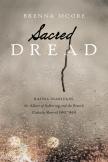A Convert's Pursuit of Faith
In Sacred Dread Brenna Moore offers a fascinating account of the life and times of Raïssa Maritain, one of the more hidden, yet highly influential figures of the intellectual revival known as the renouveau catholique. Married to the prominent Catholic theologian Jacques Maritain, the Jewish-born Raïssa converted to the Catholic Church in 1909 and spent much of her life pursuing a spiritual life through silence, prayer, the reading of mystical texts and exchanges with important artists and intellectuals of her day.
The early 20th century was a period of religious and theological vibrancy in the French Catholic Church, and Raïssa Maritain’s writings provide a window into the worldview and experiences that shaped that period. An important theme in Maritain’s work, as in that of many Catholic authors of that time, is the role of suffering in spiritual life. Moore traces this theme throughout the life and spiritual journey of Maritain, pointing to the diverse and complex ways in which it expressed itself in her experiences and thinking. Instead of reducing the theme to the common religious trope of the suffering female, Moore nuances the theme, pointing to the various meanings suffering acquired in the life and writings of Maritain, from the existential pain of being confronted with a purely positivistic account of reality in her early years, through the physical suffering brought on by severe sickness, to desperation over the meaningless suffering of millions of Jews during the Holocaust.
Moore paints a lively picture of the various figures who exercised a strong influence on Maritain, from Bergson to Péguy to Leon Bloy. Her account of the relationship between the two Maritains and Bloy, who became Raïssa’s godfather and mentor in the Catholic faith, is particularly enlightening. Not only did she embrace Bloy’s view of suffering as a point of access to a transcendent reality; she also internalized his ambivalent approach toward Judaism as exemplary of redemptive suffering but as destined to be absorbed into Christianity. However, as Moore points out, Maritain did not merely repeat Bloy’s understanding of suffering, but she “forged an improbable and innovative combination of Thomistic metaphysics and Bloy’s deeply feminized, agonized sanctity, creatively dissolving the rift between feminized affect and masculinized intellect.”
Though Maritain was herself confronted with various forms of suffering throughout her life, from exile to severe illnesses which brought her to the brink of death, her writings focus mostly on suffering as an internal and spiritual experience, located in the will and arising from religious desire. Through quotations from her journals and writings, Moore brings to life an image of a true mystic, whose religious experiences continued to inspire her husband, even after her death.
An important theme throughout the book is Raïssa’s relationship to the Jewish tradition in which she was born. Though converted to Christianity, Maritain continued to maintain close relationships with Rus-sian Jewish immigrants and artists who visited her salon in Meudon, outside of Paris. Against the growing anti-Semitism of her times, Raïssa became a strong spokesperson of what came to be known as philo-Semitism, a movement of thought that affirmed the reality and the value of Judaism as a faith distinct from but closely related to Christianity. Without questioning the motives of Maritain, Moore sheds some light on the tensions and ambiguities involved in this attitude toward Judaism. While Maritain’s wartime poems reflect a deep solidarity with the suffering of the Jews, she continued to advocate for their conversion “because French Catholicism, so saturated with suffering, could accommodate and recognize them.” Moore pointedly comments that “within this powerful rhetoric there is both inherent compassion and potential violence.”
Sacred Dread is a remarkable achievement, especially considering it is the author’s first book. It weaves history, biography and theology together in a profoundly captivating narrative that is both interesting and inspiring. It opens up a world of religious and theological intensity and creativity that, though not without its own problems and unresolved tensions, provides ample food for continued theological reflection. Though the theme of suffering may no longer exercise the same allure on spiritual practice and theological thinking, it remains a constitutive dimension of Christian identity. Moore’s book and Maritain’s life offer us a powerful reminder of this.
This article also appeared in print, under the headline “A Convert's Pursuit of Faith,” in the May 27, 2013, issue.








